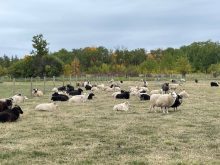Weather is often the greatest factor that influences crop production across the Prairies — in particular, growing season precipitation and level of heat. The southern Prairies, particularly the regions of the Brown and Dark Brown soil zones, have the lowest growing-season precipitation, in the range of 150 to 200 mm (six to eight inches) and the highest evapotranspiration levels. Periodic droughts are a fact of life for farmers in these areas. After a poor crop year, a typical comment is “Well, there’s always next year!”
In southern Alberta, seven of the past 10 years have been drier than average. As the 2024 cropping season approaches, there is concern we may have another hot dry summer. We are in an El Niño winter, which typically results in warmer winter temperatures and less precipitation. This increases the potential for another drier-than-normal growing season in 2024.
Read Also

Gentle treatments for pain in the neck
Heading toward year-end, people unknowingly tense up against the cold and busyness, causing neck pain that can often be treated with appropriate support and gentle mobility, athletic therapist Kathlyn Hossack says.
We constantly hear comments about variable weather and global warming. For this article, I thought I would reflect on the variability of weather for the past 10 years. In my examples, I have used the Environment Canada weather station at Agriculture and Agri-Food Canada’s Lethbridge Research and Development Centre, in the Dark Brown Soil zone of southern Alberta.
The series of charts, Figures 1 to 10 below, provide the accumulated precipitation and growing degree days (GDD, a measure of accumulated heat) from April 1 to Aug. 31 for the years 2014 to 2023. The red line on the graphs is the accumulated measure of precipitation or GDD; the blue line is the long-term average from 1963 to present. All graphs were created using Alberta Agriculture and Irrigation’s Climate Information Service. For these graphs, a GDD is calculated daily with 5 C as a base, using this formula:

In the past 10 years at Lethbridge, 2014 (Figure 1) was the only year with above-normal growing season precipitation, at 125 per cent. Just one year, 2020 (Figure 7), had near-normal precipitation that was also near-normal in its distribution. In 2016 (Figure 3), total growing season precipitation was near normal, but precipitation distribution was not normal. Precipitation was below normal most of June and the first half of July in 2016, when crop water use was high, resulting in reduced in crop yield potential — but by the end of August, total accumulated precipitation was near normal.

The remaining seven years (Figures 2, 4, 5, 6, 8, 9 and 10 had below to well below normal precipitation. Most of these drier growing seasons also had higher than average GDDs. As shown in the table above, six of those years had less than 70 per cent of normal precipitation, which are considered a drought.




















Another important factor to consider is stored soil moisture at the time of planting. In years with less than 50 mm (two inches) of stored soil moisture, the chance of drought stress is increased. When spring stored soil moisture plus precipitation is less than 100 to 150 mm (four to six inches) in the growing season, low to very poor crop yields are often inevitable.
The challenge for Alberta and Saskatchewan dryland farmers in the Brown and Dark Brown soil zones is soil and crop management. Some soil moisture conservation practices to consider include:
Direct seeding
Most farmers already use direct seeding systems to minimize soil disturbance. The less the soil is disturbed at seeding, the less soil moisture is lost due to soil disturbance. Further, no-till contributes to improved soil quality and increased soil organic matter over time, which can increase soil water holding capacity. Over a period of years using no-till, a layer of organic mulch can develop on the soil surface, which improves soil water infiltration and reduces water evaporation from the soil surface.
Earlier seeding
Earlier seeding can be helpful. Most farmers seed as soon as reasonable in the spring when soil and environmental conditions allow. Earlier-established crops are typically more water-use efficient, as vegetative growth occurs in the cooler part of the growing season, which can lead to higher grain yield per unit of water. Earlier seeding also contributes to total available sunlight to crops, which is greater for earlier-seeded versus later-seeded crops because an effective crop canopy is active for a longer period before days start to shorten after June 21.
READ MORE: Earlier-than-early seeding
For crops such as peas and canola, yields are reduced by temperatures greater than 30 C during flowering, so earlier seeding and crop establishment can help to reduce heat stress on crops.
Crop rotations
Use more diverse crop rotations. For each crop type grown, select the most drought-tolerant variety available. Consider including crops in the rotation that are more drought-tolerant such as mustard. Diverse crop rotations can also lead to greater water-use efficiency.
READ MORE: Rotations and the bottom line
For example, a deeper-rooted crop, such as wheat, following a shallow-rooted crop, such as pea, can take advantage of deeper moisture reserves that were unavailable to the shallow-rooted pea crop in the previous year. Growing a different crop each year can help increase organic matter content and improve soil structure. In the long term this will promote increased water infiltration and improve water holding capacity.
Check soil moisture levels in early spring
As soon as possible in the spring, check soil moisture to one metre (40 inches) with a soil probe or hand auger at different slope positions in all fields. If soil moisture conditions are adequate, proceed with normal cropping practices. However, if moisture conditions are poor and barely adequate for crop establishment, consider planting cereals and other drought-tolerant crops at slightly reduced seeding rates with reduced fertilizer rates to establish crops.
If you consider soil moisture inadequate in some fields, consider using chemical summerfallow in fields with the poorest soil moisture levels. I am not a fan of summerfallowing land, but in a worst-case scenario, if you are going into an extremely dry growing season, it might be wise to consider having a portion of your land in chemfallow for the summer. Then consider seeding to winter wheat or other winter cereals if soil moisture conditions improve by early September.
Please note, I rarely suggest chemfallow. Summerfallowing contributes to soil degradation including soil organic matter decline, reduced soil structure and quality, increased soil erosion and increased soil salinity.
These are a few of my thoughts when reviewing weather conditions over the past 10 years, with concerns of going into another drier-than-normal growing season. Repeated droughts are very tough on crop yields, farm income, soil quality and farmer mental health. I sincerely hope we do not have to deal with another drought year in 2024.
















